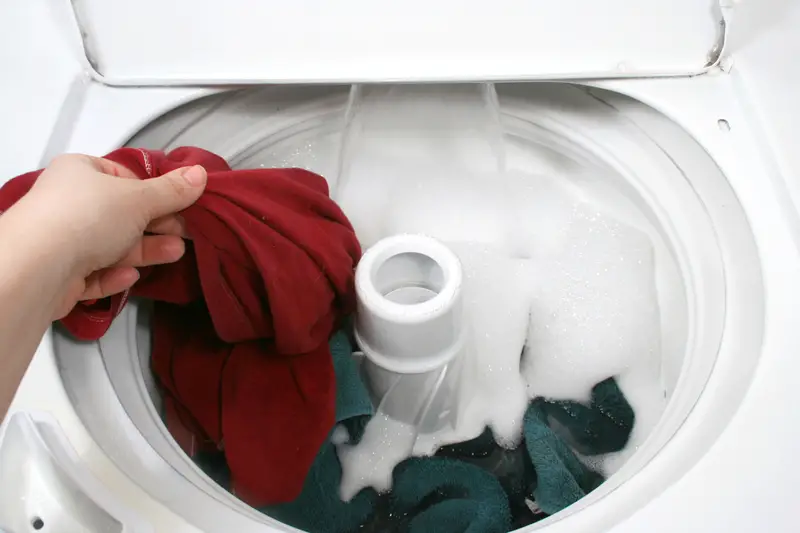Have you ever pulled your “clean” towels out of the dryer only to notice they still smell a bit funky? Or wondered why your kitchen towels never seem quite as fresh as they should be? The culprit might be hiding in your washing machine settings. While cold water washing saves energy and works great for many clothes, some items just won’t get properly clean without the power of hot water. Using the wrong temperature can leave bacteria, odors, and grime behind – even after a full wash cycle with plenty of detergent.
Kitchen towels and dishcloths need hot water sanitizing
Think about what your kitchen towels go through daily – wiping up spills, drying your hands after handling raw meat, and soaking up food residue. These cloths are breeding grounds for harmful bacteria like E. coli and Salmonella. Cold water simply won’t cut through the grease and oils that trap bacteria in the fibers. When you wash kitchen linens in cold water, you’re basically giving those germs a gentle bath rather than eliminating them. Even worse, you might be spreading those same bacteria to other items in your laundry load.
For proper cleaning, kitchen towels and dishcloths need hot water washing at least 130°F, which is the temperature needed to kill most household bacteria. If your kitchen towels have developed a persistent smell that won’t go away, that’s a telltale sign they haven’t been properly sanitized. Adding a cup of white vinegar to the wash can help break down grease and remove odors that have built up over time. For best results, wash kitchen linens separately from other clothes to prevent cross-contamination and use a heavy-duty detergent designed to cut through stubborn grease.
Bed sheets and pillowcases harbor invisible allergens
Every night while you sleep, your bed sheets collect a cocktail of sweat, skin cells, body oils, and dust mites. These microscopic critters feed on the dead skin cells we shed and can trigger allergies in many people. Cold water washing might remove surface dirt, but it won’t effectively eliminate these allergens. When you sleep on sheets washed in cold water, you’re essentially lying on a buffet for dust mites all night long. This can lead to worsening allergies, stuffy noses in the morning, and even skin irritation for sensitive individuals.
Hot water washing at 130°F or higher is necessary to kill dust mites and wash away the allergens they leave behind. For maximum effectiveness, wash your sheets and pillowcases once a week, and consider using a hypoallergenic detergent if you have allergies. If you notice your allergies acting up more at night or in the morning, it might be time to reevaluate your sheet-washing routine. For people with severe allergies, adding an extra rinse cycle can help ensure all detergent residues are completely removed, further reducing potential irritants in your bedding.
Underwear and socks require higher temperatures
Let’s be honest – underwear and socks get dirtier than most other clothing items. They’re in direct contact with areas of your body that produce sweat and bacteria all day long. Studies have shown that cold water only removes about 60% of bacteria from underwear, while hot water can eliminate up to 99%. That’s a huge difference when you think about the sensitive areas these garments cover! Continuing to wash these items in cold water means you’re putting partially cleaned underwear against your skin day after day, which can lead to unpleasant odors and potentially even infections.
For proper hygiene, underwear and socks should be washed in the hottest water the fabric can handle. If you’re concerned about damage to delicate underwear fabrics, consider using a mesh laundry bag to protect them during washing. Most cotton underwear can withstand hot water without issue. For synthetic fabrics or items with elastic, check the care label first. If you’ve been experiencing persistent odors in your underwear or socks despite regular washing, switching to hot water cycles could make a significant difference. Remember that bacteria thrive in warm, moist environments, so underwear and socks that remain even slightly contaminated after washing can quickly develop odor problems again.
Towels become breeding grounds for bacteria
Bath towels spend their lives in the most humid room of your house, getting wet and then hanging to dry in an already moist environment. This creates perfect conditions for bacteria and mildew growth. When you wash towels in cold water, you might remove some surface dirt, but you’re not killing the bacteria embedded deep in the fibers. That’s why towels washed in cold water often develop that musty smell after just a few uses – they’re harboring live bacteria that multiply every time the towel gets wet again. The problem gets worse over time as bacteria colonies grow larger with each incomplete washing.
Hot water (at least 130°F) is essential for properly cleaning towels because it kills bacteria and helps release body oils trapped in the fibers. For maximum freshness, wash towels separately from other laundry and avoid overfilling the washing machine, as towels need room to move freely in the water. Adding a laundry sanitizer designed to work in all water temperatures can provide extra germ-killing power. If your towels have already developed stubborn odors from being washed in cold water, try washing them with a cup of white vinegar and no detergent first, followed by a regular hot water wash with detergent to reset their freshness.
Workout clothes hold onto sweat and odors
After a good workout, your exercise clothes are soaked with sweat, skin oils, and bacteria. These synthetic fabrics are designed to wick moisture away from your body, but this same property makes them especially good at trapping odor-causing bacteria deep in the fibers. Cold water washing often fails to fully penetrate these technical fabrics, leaving behind residues that cause that notorious “clean but still smelly” problem many gym-goers experience. The smell might not be noticeable when the clothes are dry, but as soon as you start sweating again, the heat and moisture reactivate those leftover bacteria.
While some performance fabrics do require gentle washing, most modern workout clothes can handle warm or even hot water occasionally to break down the buildup of sweat and bacteria. Try turning your synthetic workout clothes inside out before washing to help the water reach the areas that collected the most sweat. Skip the fabric softener, which can clog the moisture-wicking properties of the fabric. Instead, add a quarter cup of baking soda to your detergent to help neutralize odors, or try a sports detergent specifically formulated for athletic wear. If you’re concerned about damaging expensive workout gear, alternate between cold and hot washes to balance cleanliness with fabric preservation.
Cloth diapers need thorough disinfection
If you’re using cloth diapers, you’re already making an eco-friendly choice – but washing them properly is essential for both cleanliness and your baby’s health. Cloth diapers obviously contain waste material that can harbor harmful bacteria and pathogens. While a cold water pre-rinse is useful for removing solid matter, relying solely on cold water for the main wash is simply not enough to properly sanitize these items. Parents who wash cloth diapers in cold water often notice persistent staining and odors, and in some cases, their babies may experience more frequent diaper rash due to residual bacteria.
For cloth diapers, a two-step washing process works best: start with a cold water rinse to remove solid waste, then follow with a hot water wash of at least 140°F to kill bacteria. Using a cloth diaper detergent specifically formulated for this purpose can help ensure thorough cleaning without irritating your baby’s sensitive skin. Avoid using fabric softeners or dryer sheets, which can reduce the absorbency of the diapers. For extra sanitizing power, adding a half cup of white vinegar to the rinse cycle can help eliminate lingering odors and balance the pH of the fabric. Remember to wash cloth diapers separately from other laundry to prevent cross-contamination.
Pet bedding collects fur, dander, and parasites
Our furry friends bring joy to our lives, but their bedding can become seriously dirty. Pet beds and blankets collect hair, dander, saliva, dirt from outside, and sometimes even flea eggs or mites. Cold water washing might remove some of the visible fur, but it won’t kill potential parasites or break down the oils that cause pet odor. Many pet owners notice that after washing pet bedding in cold water, it still has that distinctive “dog smell” when it gets wet again. This happens because the oils and bacteria that cause the odor weren’t fully removed in the cold water wash.
Hot water washing is essential for properly cleaning pet bedding because it kills potential parasites like flea eggs and dust mites while breaking down the oils that trap odors in the fabric. Before washing, remove as much fur as possible with a pet hair remover brush or sticky roller to prevent it from clogging your washing machine. Add a pet-specific laundry booster to help neutralize odors at the source rather than just masking them. For maximum freshness, dry pet bedding completely in the dryer on high heat if the fabric allows it – the additional heat will help kill any remaining parasites and their eggs. Washing pet bedding at least every two weeks helps prevent the buildup of allergens in your home.
Heavily soiled work clothes need extra cleaning power
If your job involves getting dirty – whether you’re a mechanic dealing with grease, a gardener covered in soil, or a painter splattered with paint – your work clothes need special attention in the laundry room. Cold water simply doesn’t have the muscle to break down oil-based stains like grease and heavy soil. When you wash these heavily soiled items in cold water, you might notice that stains seem to set in rather than wash out, becoming permanent over time. This happens because cold water can’t dissolve the oils that bind the dirt to the fabric fibers, essentially “locking in” the stains with each wash.
For work clothes with heavy soil, grease, or oil stains, hot water is much more effective because it helps break down these stubborn substances. Pre-treating stains with a degreaser stain remover before washing can significantly improve results. Turn work clothes inside out before washing to help the water and detergent reach the areas that collected the most dirt and sweat. For extremely soiled items, consider doing a pre-soak in hot water with detergent for 30 minutes before running the regular wash cycle. If you’re concerned about color fading on dark work clothes, alternate between warm and hot water washes to balance effective cleaning with color preservation.
While cold water washing is great for saving energy and preserving colors in many clothes, these eight types of laundry truly need hot water to get properly clean. Making smart choices about your washing machine settings isn’t just about clean-looking clothes – it’s about actually removing bacteria, allergens, and dirt that can affect your health and comfort. Next laundry day, take a moment to sort your items not just by color, but also by the appropriate water temperature they need for truly effective cleaning.

